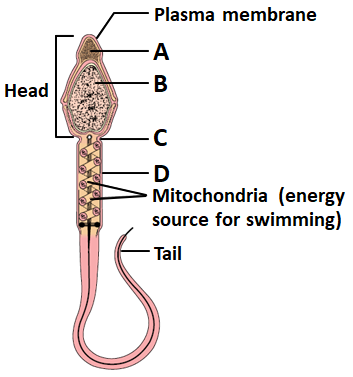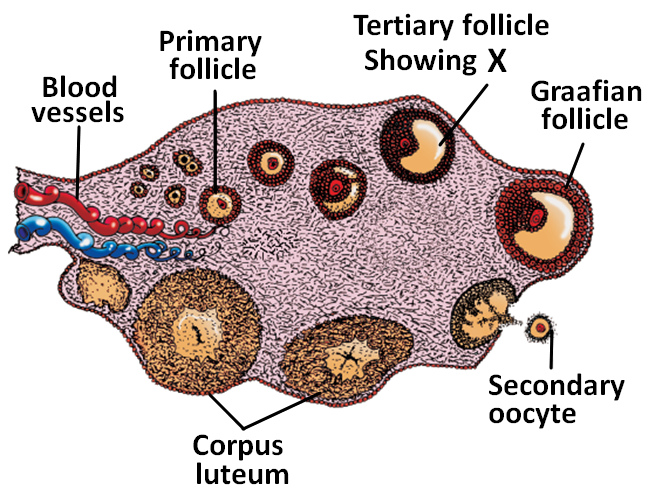Select Question Set:
In the given figure, identify the hormones represented by A, B, C and D?

A
B
C
D
1.
FSH
LH
Progesterone
Oestrogen
2.
FSH
LH
Oestrogen
Progesterone
3.
LH
FSH
Progesterone
Oestrogen
4.
LH
FSH
Oestrogen
Progesterone
Subtopic: Menstrual Cycle: Pre Ovulatory Phase | Menstrual Cycle: Luteal Phase |
80%
Level 1: 80%+
Please attempt this question first.
Hints
Please attempt this question first.
Identify the correct statements:
1. Only I and II
2. Only I and III
3. Only II and III
4. I, II and III
| I: | The reproductive cycle in the non-primate female mammals is called menstrual cycle. |
| II: | The first menstruation begins at puberty and is called menarche. |
| III: | In human females, menstruation is repeated at an average interval of about 28/29 days, and the cycle of events starting from one menstruation till the next one is called the menstrual cycle. |
1. Only I and II
2. Only I and III
3. Only II and III
4. I, II and III
Subtopic: Menstrual Cycle: Pre Ovulatory Phase | Menstrual Cycle: Luteal Phase |
83%
Level 1: 80%+
Please attempt this question first.
Hints
Please attempt this question first.
For maintenance of the endometrium, the corpus luteum secretes large amounts of:
| 1. | Progesterone | 2. | Oestrogen |
| 3. | LH | 4. | FSH |
Subtopic: Female Reproductive System-1 | Female Reproductive System-2 |
93%
Level 1: 80%+
Please attempt this question first.
Hints
Please attempt this question first.
Consider the given two statements:
| Assertion (A): | Not all copulations lead to fertilisation and pregnancy. |
| Reason (R): | Fertilisation can only occur if the ovum and sperms are transported simultaneously to the ampullary region of the oviduct. |
| 1. | Both (A) and (R) are True and (R) explains (A). |
| 2. | Both (A) and (R) are True but (R) does not explain (A). |
| 3. | (A) is True but (R) is False. |
| 4. | (A) is False but (R) is True. |
Subtopic: Female Reproductive System-1 | Female Reproductive System-2 |
95%
Level 1: 80%+
Please attempt this question first.
Hints
Please attempt this question first.
What induces the completion of the meiotic division of the secondary oocyte?
1. LH surge
2. Ovulation itself
3. Contact of sperm with zona pellucida
4. Entry of sperm into the cytoplasm of oocyte
1. LH surge
2. Ovulation itself
3. Contact of sperm with zona pellucida
4. Entry of sperm into the cytoplasm of oocyte
Subtopic: Female Reproductive System-1 | Female Reproductive System-2 | Female External Genitalia |
61%
Level 2: 60%+
Please attempt this question first.
Hints
Please attempt this question first.
Human chorionic gonadotropin is secreted by trophoblast cells as well and this hormone resembles in action to:
| 1. | LH | 2. | FSH |
| 3. | Oestrogen | 4. | Progesterone |
Subtopic: Implantation |
Level 3: 35%-60%
Please attempt this question first.
Hints
Which alphabet in the given figure represents the structure that carries two pairs of centrioles?

1. A
2. B
3. C
4. D

1. A
2. B
3. C
4. D
Subtopic: Male Reproductive Duct System | Semen and Male Fertility |
59%
Level 3: 35%-60%
Please attempt this question first.
Hints
Please attempt this question first.
At puberty, the number of follicles remaining in each ovary is between:
| 1. | 30000-40000 | 2. | 60,000-80,000 |
| 3. | 120000-160000 | 4. | 240000-320000 |
Subtopic: Female Reproductive System-1 | Female Reproductive System-2 |
92%
Level 1: 80%+
Please attempt this question first.
Hints
Please attempt this question first.
What is ‘X’ called in the given figure?


| 1. | ampulla | 2. | antrum |
| 3. | blastocoel | 4. | enterocoel |
Subtopic: Female Reproductive System-1 | Female Reproductive System-2 |
92%
Level 1: 80%+
Please attempt this question first.
Hints
Please attempt this question first.
Consider the given two statements:
| Assertion (A): | The secondary oocyte retains bulk of the nutrient rich cytoplasm of the primary oocyte. |
| Reason (R): | The division of primary oocyte is an unequal division resulting in the formation of a large haploid secondary oocyte and a tiny first polar body. |
| 1. | Both (A) and (R) are True and (R) is the correct explanation of (A). |
| 2. | Both (A) and (R) are True but (R) is not the correct explanation of (A). |
| 3. | (A) is True but (R) is False. |
| 4. | (A) is False but (R) is True. |
Subtopic: Female Reproductive System-1 | Female Reproductive System-2 | oogenesis |
65%
Level 2: 60%+
Please attempt this question first.
Hints
Please attempt this question first.
Select Question Set:






